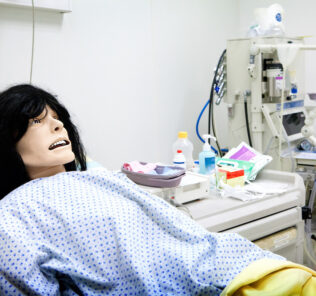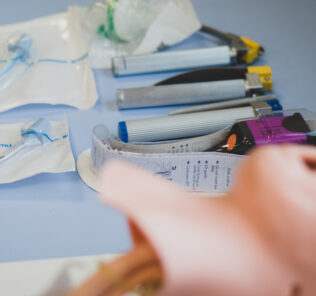Healthcare Simulation Task Trainers, For the Task at Hand
Task Trainers tend to be used in group settings throughout the medical simulation world. For example, intravenous line (IV) access training provided by the healthcare simulation team is typically found in settings such as a Nurse Residency program. There tend to be a number of newer clinicians going through the correct process and practice of successfully inserting an IV. This idea could be flipped to meet another organizational objective; creating an environment to enhance self-led learning. This HealthySimulation.com article outlines the utilization of homemade task trainers, in combination with Sim Kits and/or Sim Carts.
Resources (time, personnel, money, supplies, etc.) are driving factors when moving forward with initiatives within the healthcare simulation arena. This also tends to deter the medical simulation team members from moving forward in providing the needed education for their people. Task trainers are no different, and some simulationists would challenge task trainers to get more utilization than their high-fidelity simulators.
Yet, overutilization of a specific tool leads to the destruction of that tool. Proposing increased utilization of task trainers may seem a bit counterintuitive. However, the objective is to enhance self-led learning which offers the medical simulation team the ability to shift current healthcare simulations while capitalizing on future needed projects. Having a plan and understanding the current availability of resources allows for easier implementation.
Sponsored Content:
Many healthcare simulationists find themselves in one of the following categories at any given time:
- All funds are allocated until the next budget year. No extra money at the moment.
- There are some dollars that can be spent on needed simulation items, but limited.
- The end of the fiscal year is approaching and there is money needs to be spent.
- There was a generous donation and there is a substantial amount of money to invest in a clinical simulation initiative.
These criteria are the foundation when looking to maximize task trainer usage within the healthcare simulation curriculum. The focus should be on a self-led setting with limited to no supervision (Sim Kits). To set this scaled task trainer initiative up for success, the medical simulation team should identify the resources available, plan based on those resources, and utilize the tools at hand.
The process to acquire task trainers (determined based on funds and resources available):
- Purchase directly from a healthcare simulation company.
- This could be a full-task trainer, such as an arm for IV access, or a small simulated skin product allowing the simulation team to create their own.
- 3D-printed task trainer
- If the healthcare simulation team has access to a 3D printer, check out free stl file sites, such as thingiverse.com, which expedites this process.
- Remove parts from previous high-fidelity or low-fidelity simulators no longer in use (important that these are planned for discarding before disassembling), out-of-commission task trainers with usable skin, or any other equipment that might have been sitting in storage ready for a revival.
- Use of the simulation team’s imagination.
Central Venous Catheter (CVC) care is a recognizable need within healthcare simulation, and dressing change is a procedure that can enhance patient safety by decreasing Central Line-Associated Bloodstream Infection (CLABSI). Adding these concepts, while improvising and adding a few low-cost items, will provide a self-led module at scale with limited resources.
Sponsored Content:
Note: Providing self-led modules for dressing changes at scale with limited resources is doable. This is especially true if Sim Kits and Sim Carts have begun to take shape in the organization’s simulation culture.
Building a CVC Dressing Change Sim Kit with Homemade Task Trainers
The medical simulation team is now ready to begin building the task trainers. Having the Sim Kits premade up to this point may be easier, and assist in identifying the number of task trainers needed for assembly. Assuming that there are four kits available, obtain the necessary equipment needed to build three task trainers:
- Three identified skins
- Either procured directly from a company, 3D printed by the medical simulation team or BioMedical Department or acquired from an expired simulator
- Three CVC Surgical Kits
- If none are in the Simulation team’s supply closet, check with supply chain for any expired surgical kits.
- Three plastic food storage containers with snap lids
- Any remaining supplies needed to set the stage
- i.e. sutures to secure the CVC to the skin if none are in the surgical kit.
One of the medical simulation team members is either amazing at suturing, really enjoys attempting to suture, and/or would like the opportunity to try suturing. Capitalize on this excitement and let them become in charge of suturing the CVC to the skin. Keep in mind that this is intended for staff to practice CVC dressing changes, so ensure the placement of the CVC allows for this.
If all enjoy this process, take turns, or create a friendly competition to see who can suture the fastest and the neatest. Again, have fun with the process as this is what leads to expanding the healthcare simulation team’s amazing ideas. After the CVCs are sutured and covered with the appropriate dressing per the organization’s standards, the team can now move on to the next step.
Depending on the plastic storage container available, this step might look a little different. Due to the nature of the skill, and the space needed to practice adequately, simulationists should flip the container upside down and utilize the lid as the bottom. The container is not necessary to carry out this procedure, however, the container decreases exposure to air while in storage, thereby adding to the longevity of the task trainer.
Now that the task trainer is in a protective container, the medical simulation team can place the prepared task trainer in the associated Sim Kit, and possibly onto the Sim Cart (depending on the objectives). Once packaged, the healthcare simulation team becomes ready to place them into the hands of the learners.
To add a bit of realism to the process, healthcare simulation professionals can easily utilize a task trainer when creating their Sim Kit. This allows the medical simulation team to ensure that instructions for the utilization of the task trainer within the Sim Kit are understood while showcasing the proper technique for the task at hand.
Another great piece of advice is to always have fun. Healthcare simulation is about learning through continual exploration. When the clinical simulation team provides valuable resources to staff, the staff has an opportunity to experience meaningful practice when convenient for them. Medical simulation also allows for a genuine culture of just-in-time training, at just the right time.
How to Scale Just-in-Time Healthcare Simulation Training
With just under two decades of nursing experience, primarily in Pediatric Emergency and Healthcare Innovation and Simulation, Eric Ayers fell in love with the idea of learning through experience. He is the Founder and CEO of emc2, and host of Purpose Empowered Podcast. Ayers is an optimist and thought leader with a passion for inspiring all to reach an understanding of true personal potential. Leveraging his background in healthcare education with his MBA in Healthcare Administration, Ayers’ focus is to add value within organizations by illuminating value within their employees. He is also a husband, a father, an ideator, an innovator, an author, and a lover of both possibility and humanity. It is his intention to change the world through shifting perspectives.
Sponsored Content:




















